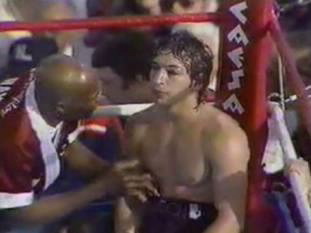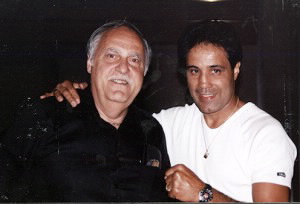 By Ted Sares – Everybody breathing dirt, eating dirt—they call it ‘pay dirt,’ for Youngstown clean would be Youngstown out of work… –Frank Bohn, 1915
By Ted Sares – Everybody breathing dirt, eating dirt—they call it ‘pay dirt,’ for Youngstown clean would be Youngstown out of work… –Frank Bohn, 1915
Like Brockton, MA, this is a gritty and hardscrabble place with a population of about 74,000, but instead of a Shoe Museum, it has a Steel Museum celebrating its major industry which has declined badly since the ‘70s. Located in a region often referred to as the Rust Belt, the city has seen better times as evidenced by the many boarded up shops, but strong efforts are now underway to revitalize the city’s post-steel image.
One constant has been a tradition of professional and semi-professional sports with the Youngstown State University Penguins being a major regional draw. The university is also a major employer. But when it comes to sports in this city, boxing takes center stage..
“Boom Boom” (1979-1992)
The original “Boom Boom” was one Lenny Mancini who was a top-ranked contender during the ‘40s and was earmarked to be a future world champion until a stint in World War 11 left him wounded. However, his son Ray picked up the mantle and eventually captured both Lenny’s dream and the World lightweight title when he stopped Arturo Frias in one round in 1982. The fight lasted 2.54 seconds as was non-stop balls to the wall fury, which is how one could describe “Boom Boom’” whirlwind style. He was all action all the time and provided great excitement for the fans.
Two fights later, Ray fought and beat Deuk Koo Kim is a tragic fight that has been well-documented. Suffice it to say, the fight led to studies that showed boxers take the most damage after the 12th round. Thus, the WBA shortened its championship matches from 15 to 12 rounds. As a tragic aside, Richard Green, the referee of that fight blamed himself for allowing the fight to go on and for Kim’s death. He took his own life a few months later as did Kim’s mother.The younger Mancini would never be the same, as he would lose his title in 1984 to an unknown and poorly scouted fighter out of the Virgin Islands by the name of Livingstone Bramble. Ray lost the rematch a year later by scores of 143-144, 142-143 and 142-143, but many (including me) thought he had won. Four years later, he lost another heartbreaker to Hector Camacho by SD.
In 1992, he returned to action in an ill-advised comeback and was beaten badly by Greg Haugen in Reno–the site of Ray’s last big win over Booby Chacon in 1984.
The thing about Ray Mancini’s career (which ended with a 29-5 mark and a solid KO percentage of 67.65) is that it represents a screen writer’s dream with it’s many cross currents and twists. For instance, some might say that his career defining fight was actually a defeat to Alexis Arguello rather than his one round war with mediocre Arturo Frias.
On a happier note, in 2005, The World Boxing Hall of Fame in Los Angeles, CA, enshrined “Boom Boom” Mancini along with bantamweight titleholders Jeff Chandler and Alfonso Zamora. Also, inducted was 60’s middleweight contender Joey Archer. The affable Mancini is now working and living happily on the West Coast with his family, ring earnings and health intact. One of those happy endings if you will
Greg “The Flea” Richardson (1982-1996)
“The Flea,” born in Youngstown, was the 1974 National AAU and National Golden Gloves flyweight champion. He also represented the US at the inaugural World Amateur Championships in Havana in 1974. He was a pure boxer with greta technical talent.
Greg’s final record stands at 31-8-1. He won five by knockout and in turn, he failed to go the distance four times. Most of his opponents had winning records and were top level fighters. They included Oscar Muniz, Romy Navarrete, Harold Petty, Jeff Fenech, Armando Castro, Gaby Canizales, and Sung-Kil Moon. As well, he was a global road warrior extraordinaire fighting from Chihuahua to Romania to South Korea to Japan and just about everyplace in between. Heck, he even fought in Youngstown twice.
As fellow writer Jim Amato wrote in an ESB piece dated February 22, 2006, “Greg won one world title [when he beat Raul Perez in 1991 for the WBC bantamweight belt in Inglewood, CA] and failed twice to win titles in two other weight classes. He had class and was a gentleman. He proudly represented the great fight city of Youngstown, Ohio.”
Jeff Lampkin (1980-1997)
During his eleven-year pro career, he won the USBA cruiserweight title and IBF cruiserweight belt. In 59 outings, he finished with a slate of 39-19-1 and an impressive KO percentage of 57.63.
He won his world title when he knocked out Glen McCroy in Gateshead, UK IN 1990. The end came in just three rounds. Lampkin defended his title by icing Siza Makathini with a body shot, but he was tripped of the title in 1991 due to a controversy surrounding his participation in an IBF bout in South Africa. The WBA and WBC to withheld recognition of his title because both bodies had sanctions against fighters who competed in that country. This was another disgraceful episode in a long series of such actions by the sanctioning bodies.
Jeff was also a global road warrior who fought in the aforementioned South Africa, Argentina, the UK, Germany, Italy, France, Denmark, and even Youngstown (when he KOd one Phil Brown in 4 in 1982).
His career ended badly when he moved up in weight and lost to such notables as Andrew Golota, Tom Glesby, Herbie Hide and Brian Nielsen (who outweighed him by almost 60 pounds). He won his last bout by stopping the terribly limited Exum Speight in four cantos.
Harry Arroyo (1980-1993)
 The author with Harry Arroyo in 1999
The author with Harry Arroyo in 1999
This warrior won his first 25 pro fights including wins over Charlie “White Lightening” Brown, Charlie “Choo Choo” Brown (for the coveted IBF lightweight title in 1984), “Rockin Robin” Blake, and Joe Manley. But it was his 25th fight with Terrence Alli that would define his career as the two engage in a blood and guts affair for almost eleven rounds. The fight took place at Bally’s in Atlantic City in January 1985 and for those who were fortunate enough to be there or to witness it on national TV, it was a memorable one with ebb and flow action and incredibly hard punches landing on the heads of the two combatants. Savage and brutal, each fighter took turns hitting the other with sharp combinations and accurate shots. Harry was hurt by a vicious uppercut in the 7th but somehow hung on. In the 11th, with the fight dead even on the judges scorecards, Arroyo, who had been down once, waged a fierce exchange with Alli finally catching him in a corner. Putting his punches together, albeit slowly, he launched a barrage of unanswered punches that snapped Alli’s neck back until Referee Tony Perez had no choice but to call a halt to the onslaught at 1:16 in what was hailed as one of the best fights of the year. Both fighters were ready to go at the end; Harry survived but at what cost? He won the battle, but likely lost the war.
In April 1985, and perhaps too soon after the Alli fight, he defended his title against rugged Jimmy Paul, 21-1, again at Bally’s. This time he lost a lopsided decision. Paul put Harry down five times to take the IBF title away from him and to signal that perhaps the Alli fight took far too much from him. Affirming this notion, Arroyo’s career then went in the same direction as that of the two Charlie’s…….and like “Choo Choo” and “White Lightening,” he too fell on hard times. Unlike those two, however, Harry’s detour resulted from a hard earned win. He went 14-10 the rest of his career. He did pick up the WBC Continental Americas Light Welterweight title from undefeated Rick Souce in 1988 only to lose it two months later by a brutal first round knockout to Loreto Garza, later WBA Junior Welterweight Champion. After dropping a 10 round UD to undefeated Vinny Letizia in 1993, Harry Arroyo called it quits with a fine record of 40 (30 KO’s)-11 and a willingness always to fight the very best opposition out there.
He now lives comfortably off his ring earnings with his wife and four children in Ohio and has become involved with law enforcement and religion. Humble, sincere, friendly, and spiritual, he is one of the nicest people you would ever want to meet.
Kelly Pavlik (2000-present)
This Youngstown-born favorite ran up 34 straight wins with an amazing KO percentage of 85.71 until he was schooled by old school Bernard Hopkins in October 2008. But if Hopkins is representative of Philadelphia fighters, Pavlik is a proud product of Youngstown.
Gritty, ethnic, and old school, he is all business and, like his hometown counterparts, does not engage in trash talk. He just goes about his business using incoming pressure to break down his opponents until they are ready for closure.
Kelly picked up the NABF crown when he stopped tough Fulgencio Zuniga in nine hard rounds in 2005. After defending that crown twice, he met Edison Miranda in a WBC middleweight eliminator and demolished “Pantera” over eight stanzas. Finally, on September 29, 2007, he got his shot at Jermain Taylor’s WBC and WBO middleweight belts. After a slow start in which he almost was taken out, he wore down Taylor and finally caught him in a corner where he rendered him helpless with a series of crunching shots. It was a classic seek and destroy effort and gave Youngstown its fifth world boxing champion.
Now, with “The Ghost” going back down to a more natural weight, most observers expect him to dominate the division for some time. Heck, why not? After all, he is from Youngstown, Ohio which–like Brockton, MA- is another City of Champions.
Visit the author’s site at www.tedsares.com